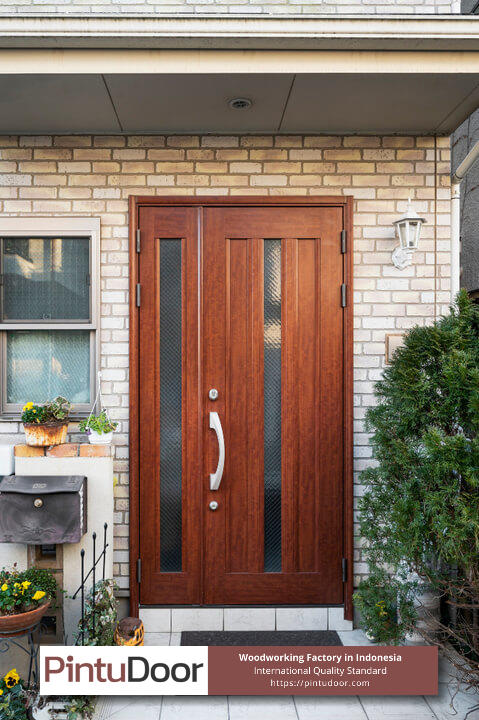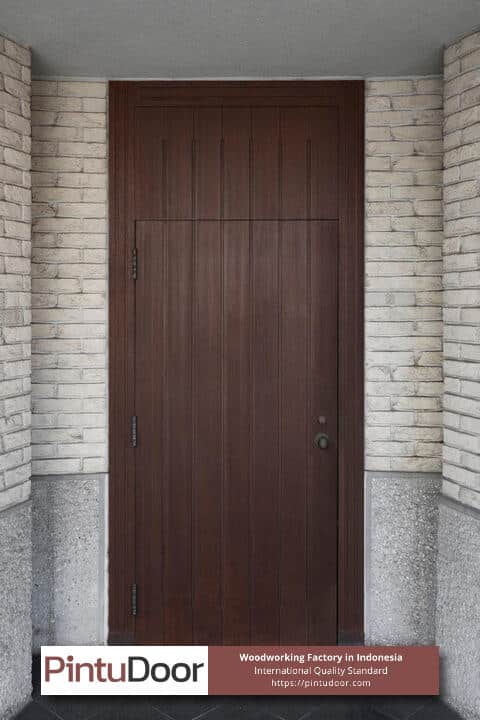
Wood veneer doors are a type of wooden door that has its characteristics and is often used for various interior applications. This door is suitable for residential, office, hotel, and commercial buildings. Especially as a dividing door between rooms, bedrooms, and living rooms.
One of its main attractions is the appearance of the original wood surface on the door, which adds elegance and natural beauty to the door. For that reason, these wood veneers are often a popular choice for those who want the aesthetic appeal of wood with added stability and cost efficiency.
To make it clearer, let’s take a closer look at wood veneers, as well as their advantages and disadvantages.
Table of Contents
What are Wood Veneer Doors?
Wood veneers are doors made of core material, such as solid wood or engineered wood. However, this type of door is not the same as engineered wood or laminate doors. All three have different construction methods and characteristics. Engineered wood doors consist of multiple layers of wood or wood composite materials, whereas laminate doors have a synthetic surface that mimics the appearance of wood.
Meanwhile, veneer doors are covered with a thin layer of wood veneer on the surface. Wood veneers are thin slices of real wood that are only 0.24 mm to 3mm thick. Generally, these wood slices are obtained by peeling or cutting logs. The veneer is then applied to the door surface. This is to give the appearance as if the door is made entirely of solid wood. All in all, check the suitable wood veneer thickness first because different part needs different thickness. Usually the panels use thiner veneer, while the door rails and stiles us thicker veneer.
The Advantages of Wood Veneer Doors
Natural Aesthetics
This type of door displays the natural beauty of wood with the unique grain and pattern of the various types of wood. This gives it a natural look that no other handmade door can replicate.
More Affordable Costs
Veneer doors tend to be more affordable than solid wood doors. This is because they use thin layers of wood which can produce the look of real wood at a lower cost than using whole solid wood.
Stability
This type of door is generally more stable than solid or massive wood doors. A strong door core such as solid wood or plywood provides structural strength and durability. While the veneer layer helps prevent significant dimensional changes due to changes in temperature and humidity. The combination of the two reduces the risk of distortion to the door, including shrinkage, swelling, or shifting.
Choice of Variations
There are various types of veneer available to choose from, including oak, maple, cherry, walnut, and more. This variety not only gives you a wide choice of designs, but also colors, grain patterns, and natural textures to suit your taste and interior design needs.
Disadvantages of Wood Veneer Doors

The disadvantages that wood door veneers have are as follows.
Easier to Wear and Damage
This type of door has a thin layer of wood. This makes it susceptible to wear and tear over time. Heavy use or scratching can wear away layers of wood and reveal the underlying core.
Requires Special Care
Veneer doors require proper care to keep them looking and looking good. This includes regular cleaning and applying protective coatings or finishes to maintain the luster and beauty of the wood.
Cannot Be Used for Exterior Applications
These doors are generally more suitable for indoor use. Although they have resistance to temperature changes, they do not have resistance to extreme weather. Especially to direct and continuous exposure to sunlight, humidity, or water. When used outdoors, they tend to be more susceptible to damage and changes in conditions.
Not Uniform
Because veneers are a natural product, there is likely to be a great deal of variation in appearance and color from one door to another, even within a single set of doors. This can be a problem if you’re looking for a consistent, uniform look throughout your room or property.
How to Care for Wood Veneer Doors
Here are some steps to take care of wood veneer so that it looks beautiful and maintains its durability.
Clean Regularly
Clean the door regularly using a soft cloth or sponge moistened with warm water. Avoid using harsh or abrasive cleaning agents that can damage the veneer. Also, avoid using excessive water which can damage the wood.
Use a Protective Layer
To protect the veneer, use a special protective film or finish designed for wood. This will help protect the door from scratches, stains and minor damage. Be sure to follow the directions for the wood protection product you use.
Avoid Scratches and Bumps
Try to avoid scratches or impacts that can damage the veneer layer. If there are minor scratches, you can try using a suitable wood repair product to cover them up.
Observe the Manufacturer’s Instructions
Each wood veneer doors manufacturer may have specific care and maintenance guidelines. It is important to pay attention to the instructions and recommendations provided by the manufacturer to ensure proper care.
